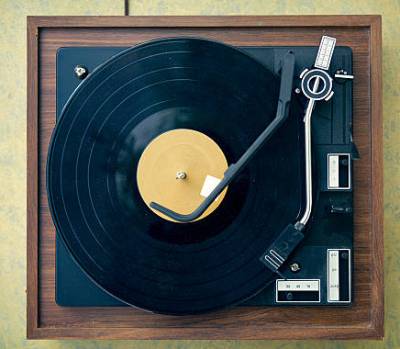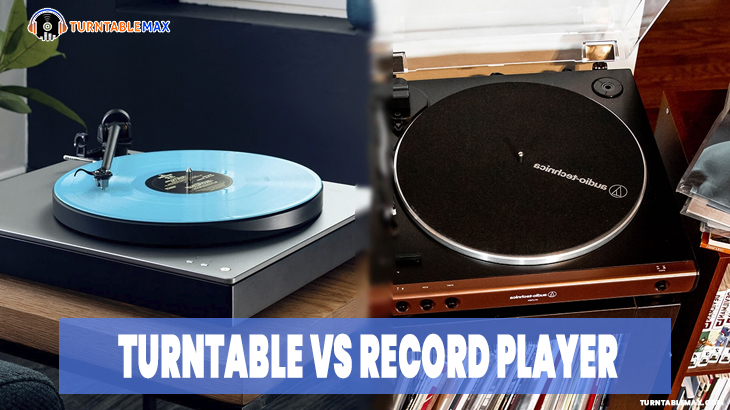If you are a music fan and a vintage lover, you will succumb to the charm of the record player and TurntableTurntable. This device used to play music has delighted several generations.
Today thanks to the prowess of technology and several years of testing, it is back in fashion with improvements that make it modern while retaining what made its success.


The term turntable has gradually become synonymous with TurntableTurntable, and they are generally used interchangeably. However, there is a difference between the two.
A turntable is part of the record player where you place the record. The device includes a cartridge and tonearm that can generate an electrical signal from the vinyl records.
A complete turntable setup requires a preamp, amplifier, and separate speakers. A record player is an all-in-one device. It includes both the TurntableTurntable, cartridge, arm, and speakers or an amplifier in one unit.
WHAT’S THE DIFFERENCE BETWEEN TURNTABLE VS RECORD PLAYER
TURNTABLE
The TurntableTurntable is a device used to read vinyl records and transform them into low-intensity signals known as Phono signals.
RECORD PLAYER
As we all know, it is an all-in-one vinyl spinner. The record players have all the necessary components of a turntable including, preamp, amplifier, and speakers – everything integrated into one unit.
TURNTABLE:
Preamp:
The Turntable’sTurntable’s preamplifier amplifies the electrical signals from the cartridge, amplifying the audio signal so that you hear the music when it finally hits the speakers.
Many consumer turntables come with a built-in amp, but high-quality audiophile turntables usually require an external preamplifier which RCA cables must connect. If your TurntableTurntable is equipped with a USB output, it has a built-in preamp.
Amplifiers:
They are used to strengthen the audio signal further than the preamp to get enough strength to drive through speakers.
Some speakers come with inbuild amplifiers and are known as powered speakers. If you are going to use a passive speaker, then you will probably need a hi-fi stereo amplifier to connect your TurntableTurntable and speakers.
Speakers:
They are used to convert the amplified signals from the TurntableTurntable into music that we hear.
The platter:
The turntable platter is the circular part of the TurntableTurntable, which spins and where you place your record. Most decks come with a turntable anti-slip mat made up of rubber or felt mat to reduce vibration and protect your precious vinyl.
Isolation pad:
Besides providing a stable base, the Turntable’s feet are designed to dampen or absorb vibrations that negatively affect the Turntable’sTurntable’s sound quality.
The best isolation pad must be placed on a perfectly level surface to balance the tonearm. For this reason, some turntables are equipped with adjustable feet.
Belt drive or direct drive:
The two most widely used types of turntables are belt drive turntables and direct drive turntables.
These are typically used by DJs who need to “scratch” and play their records backward, while belt-driven turntables are typically used for home listening.
Rotation speed selector:
Select a speed of 33 or 45 rpm. 78 rpm is selected by simultaneously pressing the two buttons 33 and 45; both buttons should be on. Be careful, though, because not all vinyl turntables offer 78 rpm.
The Quartz button:
It allows you to activate and deactivate the pitch function. When quartz is on, the TurntableTurntable will maintain the towers at a 0% pitch, regardless of the pitch fader position and tempo range control settings.
Pitch adjustment slider: Used in conjunction with the pitch knob to adjust the turntable rotation setting.
Tonearm:
The tonearm is the part that guides the cartridge’s diamond into the grooves in the vinyl. It should be carefully balanced so that the tip of the diamond fits properly into the groove without deviating to one side or the other.
The counterweight: It balances the tonearm and fine-tunes the adjustment position to obtain the optimum downforce.
Anti-skating:
While the record is playing, a force acts on the stylus to pull it inward. This force can be counterbalanced by setting the same values for anti-skating force and downforce.
The cell:
The turntable phono cartridge is attached to one end of the tonearm and contains the diamond, which fits into the vinyl record’s grooves. As the platter spins the record, vibrations pass through the diamond and enter the cartridge, where magnetic coils convert the kinetic energy of those vibrations into an electrical signal.
When you buy a vinyl turntable, it usually ships with a pre-installed phono cartridge. If the stylus/needle gets damaged, or you get the audiophile bug and want to experience more details from your records, then the cartridge can be upgraded.
RECORD PLAYER
The main difference between a record player and a turntable is the absence or presence of speakers and amplification. Turntables have none of these elements and require additional components to generate enough electrical signal to trigger headphones or speakers.
TURNTABLE VS RECORD PLAYER? WHICH IS BETTER?
Turntable vs Record Player both has their pros and cons. Moreover, everyone has their criteria based on which they select the device. My personal opinion is, comparatively TurntableTurntable is better. If you ask why? Let me give you two main reasons for it.
- Sound quality:
Usually, the sound quality of the record player has very low intensity. Since they are compact, they have small inbuilt speakers that will not be able to reproduce the exact lower bass tones in the music. Moreover, the cost of most record players is available at a low cost. It is because the components might have to be cheap and of low quality.
On the other hand, even if you get a turntable with a preamp inbuilt for a reasonable price and connect it to a reasonably good set of powered speakers, the audio quality will exceed multiple times that of almost all the record players.
- Build quality:
The build quality of a record player is usually very poor compared to the Turntable’sTurntable’s build quality. This is because turntables are built to last as long as they can. On the other hand, Record players are built to be cool, lightweight, portable, has pretty much everything included, and are low priced. Therefore, it is possible to manufacture a record player with good build quality, but it will cost more.
Being said that, even for the very lowest-priced, turntables offer better build quality when compared to the record players in general. And will last for longer years.
DEVICE SET UP AND CONFIGURATION TURNTABLE VS RECORD PLAYER
The main difference between a record player and a turntable is the absence or presence of speakers and amplification. Turntables have none of these elements and require additional components to generate enough electrical signal to trigger headphones or speakers.
Turntable:
There are various methods to set up and configure turntables. If you want more detailed procedures, check this guide to set up a turntable. Let me give a brief answer for comparison. For the turntable set, you will need essential components, namely,
- Turntable
- Preamp (inbuilt or standalone)
- Amplifiers (inbuilt or standalone)
- Speakers
Record players:
All you need to do is, connect it to the power supply, place the vinyl record on it, and hit the play button. That’s it, and you are good to go.
CONCLUSION
A record player is simply a turntable with built-in speakers and an amplifier. Most portable devices are usually record players. On the other hand, a turntable is a unit where the stylus or cartridge reads data from the disc and then generates a low-level electrical signal that goes to the preamplifier. Then the signal goes directly to the power amplifier for amplification, and headphones or speakers optionally produce the sound.
So it’s up to you. I have almost covered everything you need to about both TurntableTurntable and record player. I hope this article is useful for you.


